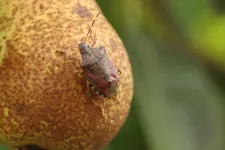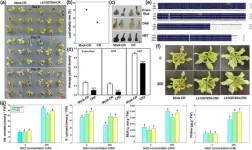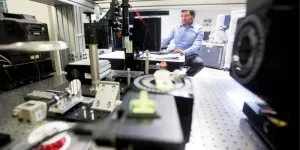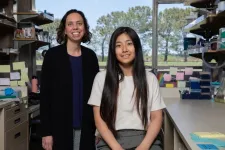(Press-News.org) Researchers in Italy have unveiled the first successful application of commercial drones combined with artificial intelligence (AI) to monitor the invasive agricultural pest, Halyomorpha halys, commonly known as the brown marmorated stink bug. This research, published in the SCI journal Pest Management Science, marks a significant advancement in the use of unmanned aerial vehicles (UAVs) for automated monitoring of invasive species.
Halyomorpha halys is notorious for its extensive damage to orchard crops across North America and southern Europe. In Italy, this invasive pest caused an estimated €588 million in damage to fruit production in 2019. Traditional monitoring methods, such as pheromone traps, visual sampling and sweep-netting are labour-intensive and often ineffective over large areas.
‘Current monitoring methods have some important drawbacks, such as “trap spillover” and the need and cost for operators to perform active monitoring,’ explained Daniele Giannetti, a researcher at the University of Parma and co-lead author on the paper.
‘Our aim was to find a reliable way of monitoring these invasive insects without the negative effects of the time and energy consuming methods currently used’ points out Lara Maistrello, a professor at the University of Modena and Reggio Emilia and co-lead author of the study.
Drones reduce disruption
The researchers developed an automated flight protocol, controlled via a mobile app, to capture high-resolution images of pear orchards at heights of up to eight metres. Notably, the drones were found to be much less disruptive to bugs than the presence of human observers, allowing more accurate data capture on pest distribution. Adult bugs were found to exhibit a freezing behaviour in response to the presence of an UAV, which helped to facilitate the capture of high-resolution images.
AI for autonomous pest recognition
The image dataset was used to train, validate and test AI models on identifying H. Halys. Transfer learning models, which leverage pre-existing recognition capacities, significantly outperformed models trained from scratch, with the highest performing model achieving a detection accuracy of 97%. On the effectiveness of the AI models, Giannetti noted, ‘Overall, this novel monitoring system demonstrated the potential of integrating UAV and AI to detect and quantify the presence of insect pests with the size and shape of H. halys.’
The implications of this technology are significant for integrated pest management strategies, including the development of precise forecasting models that adapt to meteorological and environmental conditions. ‘This is particularly important today in the face of rapid climate change,’ noted Giannetti.
Looking beyond stink bugs
The novel monitoring system has the potential for wide-ranging applications.
‘The imaging application can be easily adapted to different crops,’ explained Maistrello. ‘Of course, if you want to move on to other insects, you will have to train new models, but this experience is really encouraging. We find these results exciting, especially because their future applications are so many.’
END
Drones and AI harnessed to monitor invasive stink bugs
2024-06-05
ELSE PRESS RELEASES FROM THIS DATE:
Unlocking salt resistance: sea lavender's genetic secret revealed
2024-06-05
Recent research has uncovered the genetic mechanisms behind sea lavender's (Limonium bicolor) salt tolerance by studying basic helix–loop–helix (bHLH) transcription factors. Identifying 187 bHLH genes, the study highlights their roles in salt gland development and stress responses. CRISPR-Cas9 validation demonstrated specific bHLH genes' critical role in enhancing salt tolerance, paving the way for future applications in crop improvement and saline soil management.
Basic helix–loop–helix (bHLH) transcription factors are essential for various plant processes, including ...
Six UTA faculty receive prestigious CAREER grants
2024-06-05
Six faculty members from The University of Texas at Arlington received more than $3.23 million in awards as part of the National Science Foundation’s (NSF) Faculty Early Career Development Program. Called CAREER, these awards are considered the NSF’s most prestigious for early-career faculty and are given to those who have the potential to serve as academic role models in research and education.
Between 2017 and 2022, UTA received nine CAREER awards; in 2023, it received six. Vice President of research and innovation Kate C. Miller called this “a true testament to the world-class research teams we’re assembling here in Arlington.”
“CAREER ...
Brain overgrowth dictates autism severity, new research suggests
2024-06-05
Some children with autism experience profound, lifelong difficulties like developmental delay, social struggles and even the inability to speak. Others experience more mild symptoms that improve with time.
The disparity in outcomes has been a mystery to scientists, until now. A new study, published in Molecular Autism by researchers at University of California San Diego, is the first to shed light on the matter. Among its findings: The biological basis for these two subtypes of autism develops in utero.
Researchers ...
MD Anderson Research Highlights for June 5, 2024
2024-06-05
HOUSTON ― The University of Texas MD Anderson Cancer Center’s Research Highlights showcases the latest breakthroughs in cancer care, research and prevention. These advances are made possible through seamless collaboration between MD Anderson’s world-leading clinicians and scientists, bringing discoveries from the lab to the clinic and back.
Recent developments at MD Anderson offer insights into a lower-intensity therapy combination for older patients with acute myeloid leukemia (AML), a novel T cell therapy for patients with bone marrow failure syndromes, a proof-of-concept study using MRI to detect metabolic changes inside tumors, a molecular target to overcome treatment resistance ...
New study finds many of the world’s most threatened species lack evidence of sufficient conservation efforts
2024-06-05
-With images-
A new study has revealed alarming gaps in the implementation of conservation interventions for thousands of the world's most threatened species.
The research, published in the journal Nature, shows that most terrestrial plant and animal species at risk of extinction from threats like habitat loss, over-exploitation for trade, and invasive species are not receiving the appropriate types of conservation efforts needed to protect them.
The study findings suggest that there is a serious mismatch between the ...
BU study: Black-specific incarceration rates are associated with Black firearm homicide rates
2024-06-05
(Boston)—Firearm-related injury remains a significant burden in the U.S. with more than 45,000 people dying from these injuries in 2020. Suicides continue to account for the majority of all gun deaths. The number of homicides due to gun violence decreased between 1990 and 2010, but the last decade has seen an uptick. Homicides now make up 45% of all gun-related deaths, and Black and other minorities are overrepresented among firearm homicide victims. Moreover, there has been a stark increase in incarcerated populations in the U.S since the 1980s largely due to differential drug sentencing, ...
New technique reveals how gene transcription is coordinated in cells
2024-06-05
The human genome contains about 23,000 genes, but only a fraction of those genes are turned on inside a cell at any given time. The complex network of regulatory elements that controls gene expression includes regions of the genome called enhancers, which are often located far from the genes that they regulate.
This distance can make it difficult to map the complex interactions between genes and enhancers. To overcome that, MIT researchers have invented a new technique that allows them to observe the timing of gene and enhancer activation in a cell. When a gene is turned on around the same time as a particular enhancer, it strongly suggests the enhancer ...
Major cause of inflammatory bowel disease discovered
2024-06-05
Researchers at the Francis Crick Institute, working with UCL and Imperial College London, have discovered a new biological pathway that is a principal driver of inflammatory bowel disease (IBD) and related conditions, and which can be targeted using existing drugs.
About 5% of the world’s population, and one in ten people in the UK1, are currently affected by an autoimmune disease, such as IBD, the umbrella term for Crohn’s disease and ulcerative colitis. These diseases are also becoming more common, with over half a million people living with IBD in the UK as of 2022, nearly double the 300,000 previously estimated2.
Despite increasing prevalence, current treatments do not ...
Cooperative proteins help the immune system identify and attack invaders
2024-06-05
LA JOLLA (June 5, 2024)—Bacteria, parasites, viruses—the immune system tackles them all. At the front line of the human immune response are cells called macrophages, which are responsible for correctly identifying intruders and then directing how the entire immune system responds. Researchers at the Salk Institute have now discovered a molecular mechanism that helps macrophages mount a coordinated response tailored to a specific immune challenge.
Activating macrophages requires the work of three versions of a protein complex called SWI/SNF: cBAF, ncBAF, and PBAF. Scientists already knew these variants had slightly different structures, but ...
Why do 1 in 10 Americans get eczema? Is it too much salt?
2024-06-05
Why Do 1 in 10 Americans Get Eczema? Is it Too Much Salt?
UCSF Study finds that changes in daily salt intake may explain eczema flares.
A high sodium diet may increase the risk of eczema, according to researchers at UC San Francisco (UCSF), who found that eating just one extra gram of sodium per day – the amount in a Big Mac – increases the likelihood of flares by 22%.
Eczema, also known as atopic dermatitis, is a chronic disease that causes dry, itchy skin. It’s one of ...






